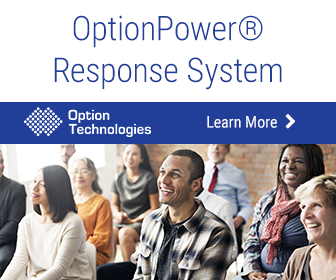Audiences have come to dread the “icebreaker,” which usually involves some sort of embarrassing warm-up activity. But aside from the groans and eye-rolling, icebreakers serve a meaningful purpose: better audience engagement.
At Option Technologies, we’ve seen some excellent presenters go far beyond just breaking the ice. We’ve helped them reshape the entire presentation into a more innovative, engaging format. Here are 5 of the freshest presentation ideas we’ve come across so far.
Idea #1: Illusion Illustrations
All eyes are already on your overhead presentation, so why not WOW them with visual drama? Share a “magic eye” image, an optical illusion, or an intricate “Where’s Waldo?” style drawing that makes a point about something: clutter, organization, attention to detail, sorting through information.
Use the illustration to interact with the audience. Ask them to find an item in the image, or ask them to share the first word that comes into their minds - and use interactive devices to show their responses live on-screen.
Stock photo services offer an array of these illustrations, or you can commission an artist to create a customized drawing. Imagine how powerful it would be to keep this image on the wall of your office after the presentation for people to notice again and again, boosting retention.
Idea #2: Live Text Response
There’s a reason American Idol has been an iconic TV show for 16 years: audience involvement. The concept of texting your vote was brand-new when the show launched in 2002, and it’s spawned many imitators in TV-land.
In fact, vote texting is so popular, CNN had to devote a webpage to the question, “Can I vote by text message?” during the last presidential election. (The answer is no, due to voting laws.)
So use this concept in your next presentation: live voting by text. The audience can be as big as you desire - from one conference room, to an entire building, to an entire town, to everyone in the world. Many city governments are now using this strategy for increased citizen engagement, replacing old-fashioned town hall meetings with tech-powered interactive conversations.

Idea #3: Emoji Feedback
Here’s one that can really ramp up audience interaction. Display their mood on-screen during your presentation. Through the use of emoji - those expressive little icons from texting and social media - you can take the pulse of the audience’s feelings on particular subjects.
When people hear information that makes them happy, confused, angry, sad, and more, they can share the appropriate emoji, which floats across the big screen but doesn’t reveal who shared it. This is a great way to acknowledge people’s feelings without singling them out.
One note about this method: Make sure the presenter comments on the changing flow of emotions during the event and the organization responds to it somehow afterward. Otherwise, people will feel ignored - the opposite of what you’re trying to accomplish.
Idea #4: Word Clouds
Word clouds are similar to emoji feedback, using text instead of images. As you progress through a presentation, ask people to share a word that summarizes their feelings, questions, or what they’ve learned.
A word cloud displays aggregated responses using descending text size by response quantity. Or, in plain language, the most popular words will be the biggest on-screen. It’s a fun and engaging way to see what’s in the minds of the audience.
Idea #5: Crowdsource Your Q&As
Our clients often ask us how to handle question-and-answer sessions, especially for large crowds. Nobody wants an otherwise terrific presentation to be hijacked by a long-winded or difficult person.
The answer lies in crowdsourcing - upvoting and downvoting audience questions before the presenter chooses which to address. In action, this means the audience submits questions first, and then has an opportunity to read through them and vote for their favorites.
The presenter then answers only the top 3 to 7 questions, trying not to exceed the 20-minute attention span of most people. The audience leaves feeling that their biggest questions were answered and any un-answered questions can be handled later through chats or emails.
Have you seen other presentation ideas that really stuck with you? Reach out to us to chat, or request a demonstration of an Option Technologies audience response system.


